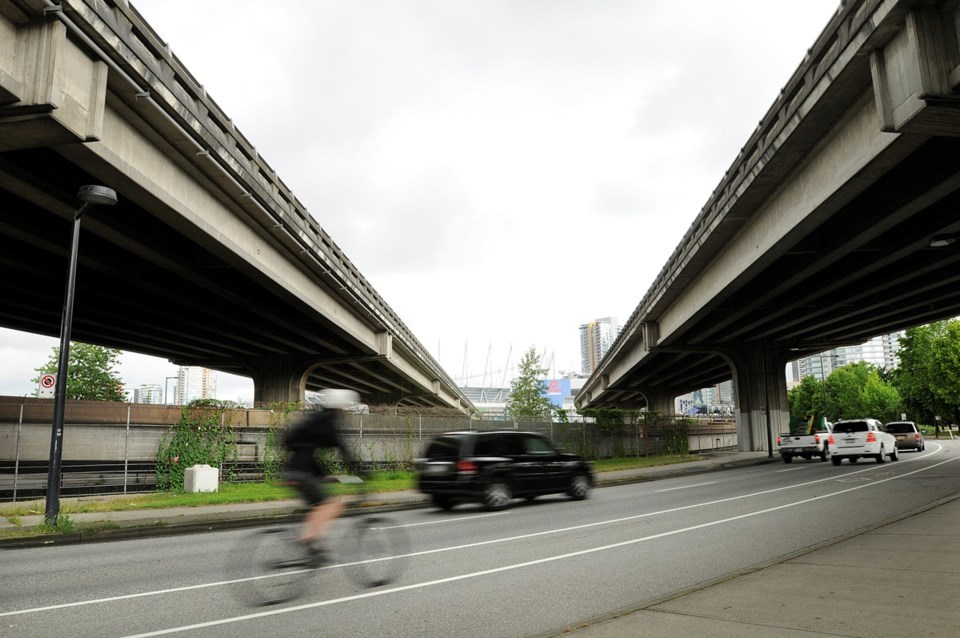Time for an update on the Georgia and Dunsmuir viaducts.
Breaking news — they’re still there!
Drove over the monstrosities recently and wondered what ever happened to the plan to knock them down. Their destruction was to trigger the creation of a new street network and the long-promised extension of Creekside Park.
A bunch of “affordable” housing was also planned for the land.
Longtime city hall watchers will recall the Gregor Robertson-led council voted 5-4 in October 2015 to demolish the elevated roadways, which have served as a link from Chinatown and Strathcona to downtown since the 1970s.
The estimated cost at the time to topple the concrete giants was $90 million to $127 million.
So why are they still standing?
Well, the same Vision Vancouver-dominated council voted in February 2018 to approve a wider plan to transform 58 hectares of land in Northeast False Creek into the equivalent of a town the size of Quesnel.
We’re talking a maze of new highrises and other forms of housing for up to 12,000 people.
“It’s an amazing opportunity to build a fantastic new neighbourhood around the stadiums and through where the viaducts are now,” said Robertson at the time.
Spread across the land would be a community centre and ice rink on the former Plaza of Nations site, 32 acres of new and redeveloped parks, at least three child-care facilities and a massive waterfront plaza and wharf lined with restaurants and pubs.
The construction of a cultural centre on Main Street to honour the Black community of Hogan’s Alley and a $30-million upgrade to the Chinese Cultural Centre of Greater Vancouver on Pender Street were also incorporated in the plan.
To do most of that, the viaducts have to come down.
I reached out to the city’s communications department this week to request an interview with the city’s head engineer, Lon LaClaire, or the city’s head planner, Theresa O’Donnell, to get an update on when the viaducts will be toppled and the status of the wider plan, but was turned down.
Instead, I received an emailed statement that said:
“The city is continuing to work on various aspects of implementing the Northeast False Creek Plan approved by city council in 2018, including the removal of the viaducts. The NEFC Plan is a multi-year plan, and funded by developer contributions; as such a specific timeline for the removal of the viaducts is not possible at this time.”
What the statement hinted at is the issues related to removal of the viaducts are complex and involve negotiations with landowners, particularly Concord Pacific.
Concord purchased the former Expo 86 properties in 1988 from the government and will see its land increase in value once the lands are reconfigured.
I reached out to Concord via email Monday for some insight on present and future development of the area, but hadn’t heard back by the time I wrote this sentence Tuesday afternoon.
For some perspective though, Concord vice-president Peter Webb told council in 2015 that the new neighbourhood planned for the area would not be solely for wealthy buyers.
“We don’t see this as a highly exclusive neighbourhood that we just sell for a fortune and wander off,” Webb said at the time.
“We understand the affordability of housing, the parks and community uses in the area, daycares, schools, seawalls, parks — all of those things are important parts of the development. And we recognize that in the rezoning process, we’ll have to address all of those topics together with the city in a sort of partnership way.”
As the city said in its email this week, it anticipates the project will be paid for with development-related revenues. Revenue will also come from the sale or lease of lands, senior government contributions and “other strategic partnerships.”
The expectation seven years ago was such arrangements will generate a surplus of $100 million when the viaducts are gone and the land is built out.
Whenever that may be.
For now, the viaducts — which staff argued in 2015 were underutilized and in disrepair to the tune of a $65-million upgrade to keep them standing after a moderate earthquake — remain operational, their date with the wrecking ball a question mark.




